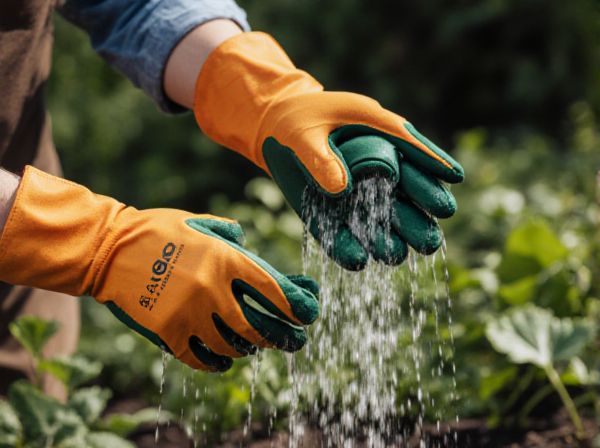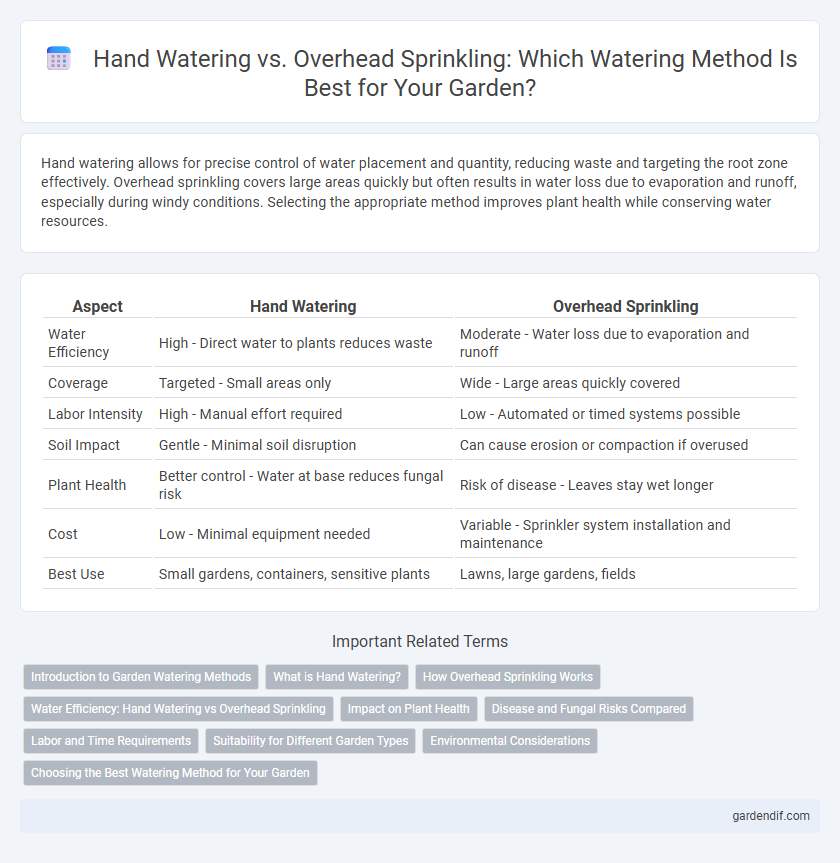
Hand watering vs Overhead sprinkling Illustration
Hand watering allows for precise control of water placement and quantity, reducing waste and targeting the root zone effectively. Overhead sprinkling covers large areas quickly but often results in water loss due to evaporation and runoff, especially during windy conditions. Selecting the appropriate method improves plant health while conserving water resources.
Table of Comparison
| Aspect | Hand Watering | Overhead Sprinkling |
|---|---|---|
| Water Efficiency | High - Direct water to plants reduces waste | Moderate - Water loss due to evaporation and runoff |
| Coverage | Targeted - Small areas only | Wide - Large areas quickly covered |
| Labor Intensity | High - Manual effort required | Low - Automated or timed systems possible |
| Soil Impact | Gentle - Minimal soil disruption | Can cause erosion or compaction if overused |
| Plant Health | Better control - Water at base reduces fungal risk | Risk of disease - Leaves stay wet longer |
| Cost | Low - Minimal equipment needed | Variable - Sprinkler system installation and maintenance |
| Best Use | Small gardens, containers, sensitive plants | Lawns, large gardens, fields |
Introduction to Garden Watering Methods
Hand watering allows precise control over water delivery directly to plant roots, reducing waste and preventing disease by keeping foliage dry. Overhead sprinkling covers larger areas efficiently but may promote fungal growth due to wet leaves and can lead to uneven water distribution. Selecting the appropriate garden watering method depends on plant type, garden size, and water conservation priorities.
What is Hand Watering?
Hand watering involves manually applying water directly to plants using tools like watering cans or hoses with spray nozzles, ensuring precise moisture delivery to the root zone. This method reduces water waste and soil erosion by targeting specific areas, making it ideal for delicate plants and container gardens. Hand watering also allows gardeners to monitor plant health closely and adjust watering frequency based on observed needs.
How Overhead Sprinkling Works
Overhead sprinkling delivers water uniformly by dispersing droplets through a network of elevated sprinkler heads covering large garden or lawn areas. This method mimics natural rainfall, allowing water to infiltrate the soil gradually and efficiently, supporting plant hydration and growth. Sprinkler systems often include timers and pressure regulators to optimize water use and minimize evaporation loss.
Water Efficiency: Hand Watering vs Overhead Sprinkling
Hand watering delivers water directly to plant roots, minimizing evaporation and runoff, which significantly enhances water use efficiency compared to overhead sprinkling. Overhead sprinklers often result in higher water loss due to evaporation and wind drift, reducing the amount of water that actually reaches the soil. Optimizing watering frequency and timing with hand watering ensures precise moisture delivery, conserving water and promoting healthier plant growth.
Impact on Plant Health
Hand watering directs water precisely to the plant's root zone, reducing leaf wetness and minimizing the risk of fungal diseases and leaf damage; it promotes healthier root development and efficient water use. Overhead sprinkling wets entire foliage, which can increase susceptibility to fungal infections, disease spread, and leaf burn under intense sunlight. Choosing hand watering enhances plant health by providing targeted moisture while reducing environmental stress factors.
Disease and Fungal Risks Compared
Hand watering reduces the risk of disease and fungal infections by minimizing moisture on plant leaves and stems, which often promotes fungal growth. Overhead sprinkling increases leaf wetness, creating an ideal environment for pathogens such as powdery mildew and downy mildew to thrive. Minimizing wet foliage through hand watering helps maintain healthier plants and lowers the incidence of common waterborne diseases.
Labor and Time Requirements
Hand watering demands considerable labor and time, as it involves manually targeting specific plants and requires constant monitoring to ensure adequate moisture. Overhead sprinkling significantly reduces labor intensity by covering large areas simultaneously, allowing for automated scheduling and consistent water distribution. This efficiency makes overhead sprinkling more suitable for extensive lawns or gardens where minimizing manual effort and saving time are priorities.
Suitability for Different Garden Types
Hand watering offers precise control, making it ideal for small gardens, container plants, or delicate seedlings where targeted moisture is critical for growth. Overhead sprinkling suits larger lawns and extensive garden beds by providing uniform water distribution, though it may cause foliage moisture that can promote disease in sensitive plants. Selecting the appropriate method depends on garden size, plant type, and water conservation goals for optimal plant health.
Environmental Considerations
Hand watering conserves water by targeting plant roots directly, reducing runoff and evaporation compared to overhead sprinkling, which disperses water broadly and often wastes significant amounts. Overhead sprinkling increases the risk of water loss through evaporation and can contribute to soil erosion and nutrient runoff, negatively impacting local ecosystems. Efficient hand watering methods promote sustainable water use and minimize environmental impact by ensuring precise moisture delivery.
Choosing the Best Watering Method for Your Garden
Hand watering provides precise moisture delivery directly to plant roots, reducing water waste and minimizing disease risk caused by wet foliage. Overhead sprinkling covers larger areas quickly but can promote fungal growth and evaporation losses, making it less efficient for delicate plants or drought-prone gardens. Selecting the best watering method depends on garden size, plant types, and water conservation goals to optimize plant health and resource use.
Hand watering vs Overhead sprinkling Infographic

 gardendif.com
gardendif.com